INT204: Essay on Leadership and Management in Community Services
VerifiedAdded on 2022/09/05
|9
|3005
|28
Essay
AI Summary
This essay provides a comprehensive overview of leadership and management within the context of community services. It begins by defining and differentiating between leadership and management, highlighting their significance in achieving organizational objectives. The essay then outlines three distinct leadership styles: autocratic, democratic, and laissez-faire, discussing their characteristics, advantages, and disadvantages. Furthermore, the essay delves into the key challenges faced by leaders and managers in the Australian community service sector, including funding issues, adapting to change, financial resource management, human resource management, and the complexities of governance. The analysis underscores the importance of effective leadership and management in navigating these challenges and ensuring the success of community service organizations. The essay is based on required textbook references and scholarly articles.

RUNNING HEAD: INTRODUCTION TO MANAGEMENT IN COMMUNITY SERVICES
0
Introduction to management in community services
0
Introduction to management in community services
Paraphrase This Document
Need a fresh take? Get an instant paraphrase of this document with our AI Paraphraser
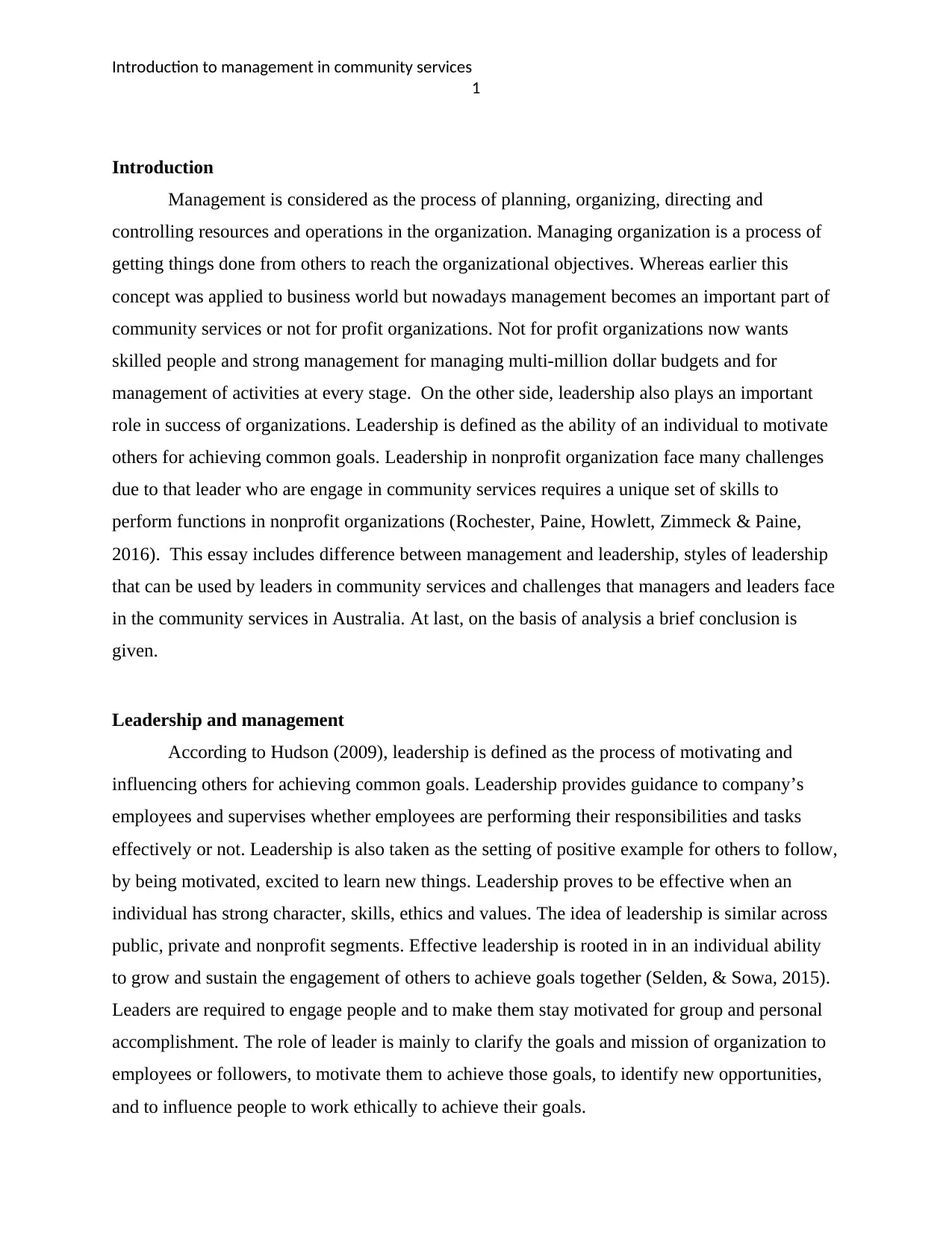
Introduction to management in community services
1
Introduction
Management is considered as the process of planning, organizing, directing and
controlling resources and operations in the organization. Managing organization is a process of
getting things done from others to reach the organizational objectives. Whereas earlier this
concept was applied to business world but nowadays management becomes an important part of
community services or not for profit organizations. Not for profit organizations now wants
skilled people and strong management for managing multi-million dollar budgets and for
management of activities at every stage. On the other side, leadership also plays an important
role in success of organizations. Leadership is defined as the ability of an individual to motivate
others for achieving common goals. Leadership in nonprofit organization face many challenges
due to that leader who are engage in community services requires a unique set of skills to
perform functions in nonprofit organizations (Rochester, Paine, Howlett, Zimmeck & Paine,
2016). This essay includes difference between management and leadership, styles of leadership
that can be used by leaders in community services and challenges that managers and leaders face
in the community services in Australia. At last, on the basis of analysis a brief conclusion is
given.
Leadership and management
According to Hudson (2009), leadership is defined as the process of motivating and
influencing others for achieving common goals. Leadership provides guidance to company’s
employees and supervises whether employees are performing their responsibilities and tasks
effectively or not. Leadership is also taken as the setting of positive example for others to follow,
by being motivated, excited to learn new things. Leadership proves to be effective when an
individual has strong character, skills, ethics and values. The idea of leadership is similar across
public, private and nonprofit segments. Effective leadership is rooted in in an individual ability
to grow and sustain the engagement of others to achieve goals together (Selden, & Sowa, 2015).
Leaders are required to engage people and to make them stay motivated for group and personal
accomplishment. The role of leader is mainly to clarify the goals and mission of organization to
employees or followers, to motivate them to achieve those goals, to identify new opportunities,
and to influence people to work ethically to achieve their goals.
1
Introduction
Management is considered as the process of planning, organizing, directing and
controlling resources and operations in the organization. Managing organization is a process of
getting things done from others to reach the organizational objectives. Whereas earlier this
concept was applied to business world but nowadays management becomes an important part of
community services or not for profit organizations. Not for profit organizations now wants
skilled people and strong management for managing multi-million dollar budgets and for
management of activities at every stage. On the other side, leadership also plays an important
role in success of organizations. Leadership is defined as the ability of an individual to motivate
others for achieving common goals. Leadership in nonprofit organization face many challenges
due to that leader who are engage in community services requires a unique set of skills to
perform functions in nonprofit organizations (Rochester, Paine, Howlett, Zimmeck & Paine,
2016). This essay includes difference between management and leadership, styles of leadership
that can be used by leaders in community services and challenges that managers and leaders face
in the community services in Australia. At last, on the basis of analysis a brief conclusion is
given.
Leadership and management
According to Hudson (2009), leadership is defined as the process of motivating and
influencing others for achieving common goals. Leadership provides guidance to company’s
employees and supervises whether employees are performing their responsibilities and tasks
effectively or not. Leadership is also taken as the setting of positive example for others to follow,
by being motivated, excited to learn new things. Leadership proves to be effective when an
individual has strong character, skills, ethics and values. The idea of leadership is similar across
public, private and nonprofit segments. Effective leadership is rooted in in an individual ability
to grow and sustain the engagement of others to achieve goals together (Selden, & Sowa, 2015).
Leaders are required to engage people and to make them stay motivated for group and personal
accomplishment. The role of leader is mainly to clarify the goals and mission of organization to
employees or followers, to motivate them to achieve those goals, to identify new opportunities,
and to influence people to work ethically to achieve their goals.
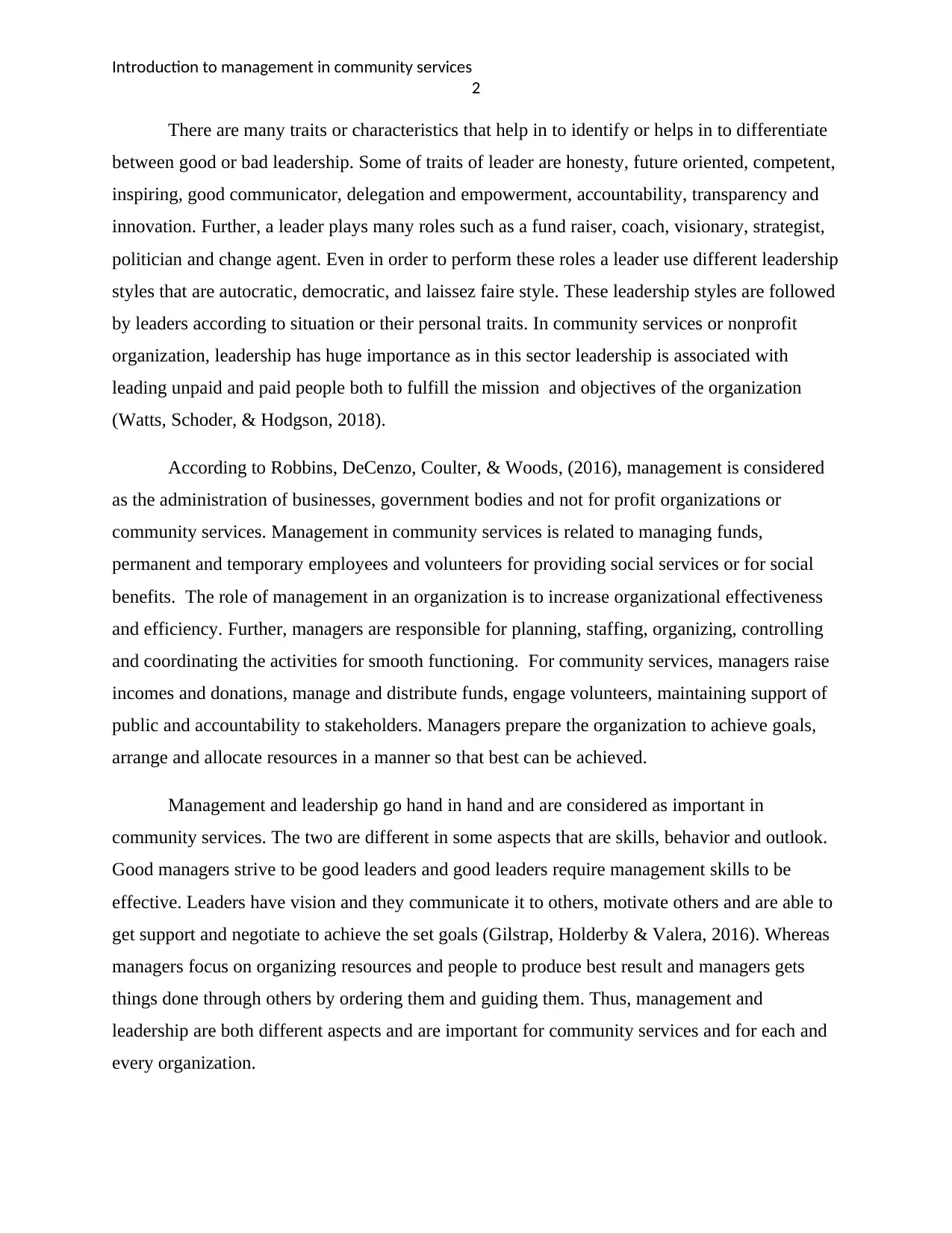
Introduction to management in community services
2
There are many traits or characteristics that help in to identify or helps in to differentiate
between good or bad leadership. Some of traits of leader are honesty, future oriented, competent,
inspiring, good communicator, delegation and empowerment, accountability, transparency and
innovation. Further, a leader plays many roles such as a fund raiser, coach, visionary, strategist,
politician and change agent. Even in order to perform these roles a leader use different leadership
styles that are autocratic, democratic, and laissez faire style. These leadership styles are followed
by leaders according to situation or their personal traits. In community services or nonprofit
organization, leadership has huge importance as in this sector leadership is associated with
leading unpaid and paid people both to fulfill the mission and objectives of the organization
(Watts, Schoder, & Hodgson, 2018).
According to Robbins, DeCenzo, Coulter, & Woods, (2016), management is considered
as the administration of businesses, government bodies and not for profit organizations or
community services. Management in community services is related to managing funds,
permanent and temporary employees and volunteers for providing social services or for social
benefits. The role of management in an organization is to increase organizational effectiveness
and efficiency. Further, managers are responsible for planning, staffing, organizing, controlling
and coordinating the activities for smooth functioning. For community services, managers raise
incomes and donations, manage and distribute funds, engage volunteers, maintaining support of
public and accountability to stakeholders. Managers prepare the organization to achieve goals,
arrange and allocate resources in a manner so that best can be achieved.
Management and leadership go hand in hand and are considered as important in
community services. The two are different in some aspects that are skills, behavior and outlook.
Good managers strive to be good leaders and good leaders require management skills to be
effective. Leaders have vision and they communicate it to others, motivate others and are able to
get support and negotiate to achieve the set goals (Gilstrap, Holderby & Valera, 2016). Whereas
managers focus on organizing resources and people to produce best result and managers gets
things done through others by ordering them and guiding them. Thus, management and
leadership are both different aspects and are important for community services and for each and
every organization.
2
There are many traits or characteristics that help in to identify or helps in to differentiate
between good or bad leadership. Some of traits of leader are honesty, future oriented, competent,
inspiring, good communicator, delegation and empowerment, accountability, transparency and
innovation. Further, a leader plays many roles such as a fund raiser, coach, visionary, strategist,
politician and change agent. Even in order to perform these roles a leader use different leadership
styles that are autocratic, democratic, and laissez faire style. These leadership styles are followed
by leaders according to situation or their personal traits. In community services or nonprofit
organization, leadership has huge importance as in this sector leadership is associated with
leading unpaid and paid people both to fulfill the mission and objectives of the organization
(Watts, Schoder, & Hodgson, 2018).
According to Robbins, DeCenzo, Coulter, & Woods, (2016), management is considered
as the administration of businesses, government bodies and not for profit organizations or
community services. Management in community services is related to managing funds,
permanent and temporary employees and volunteers for providing social services or for social
benefits. The role of management in an organization is to increase organizational effectiveness
and efficiency. Further, managers are responsible for planning, staffing, organizing, controlling
and coordinating the activities for smooth functioning. For community services, managers raise
incomes and donations, manage and distribute funds, engage volunteers, maintaining support of
public and accountability to stakeholders. Managers prepare the organization to achieve goals,
arrange and allocate resources in a manner so that best can be achieved.
Management and leadership go hand in hand and are considered as important in
community services. The two are different in some aspects that are skills, behavior and outlook.
Good managers strive to be good leaders and good leaders require management skills to be
effective. Leaders have vision and they communicate it to others, motivate others and are able to
get support and negotiate to achieve the set goals (Gilstrap, Holderby & Valera, 2016). Whereas
managers focus on organizing resources and people to produce best result and managers gets
things done through others by ordering them and guiding them. Thus, management and
leadership are both different aspects and are important for community services and for each and
every organization.
⊘ This is a preview!⊘
Do you want full access?
Subscribe today to unlock all pages.

Trusted by 1+ million students worldwide
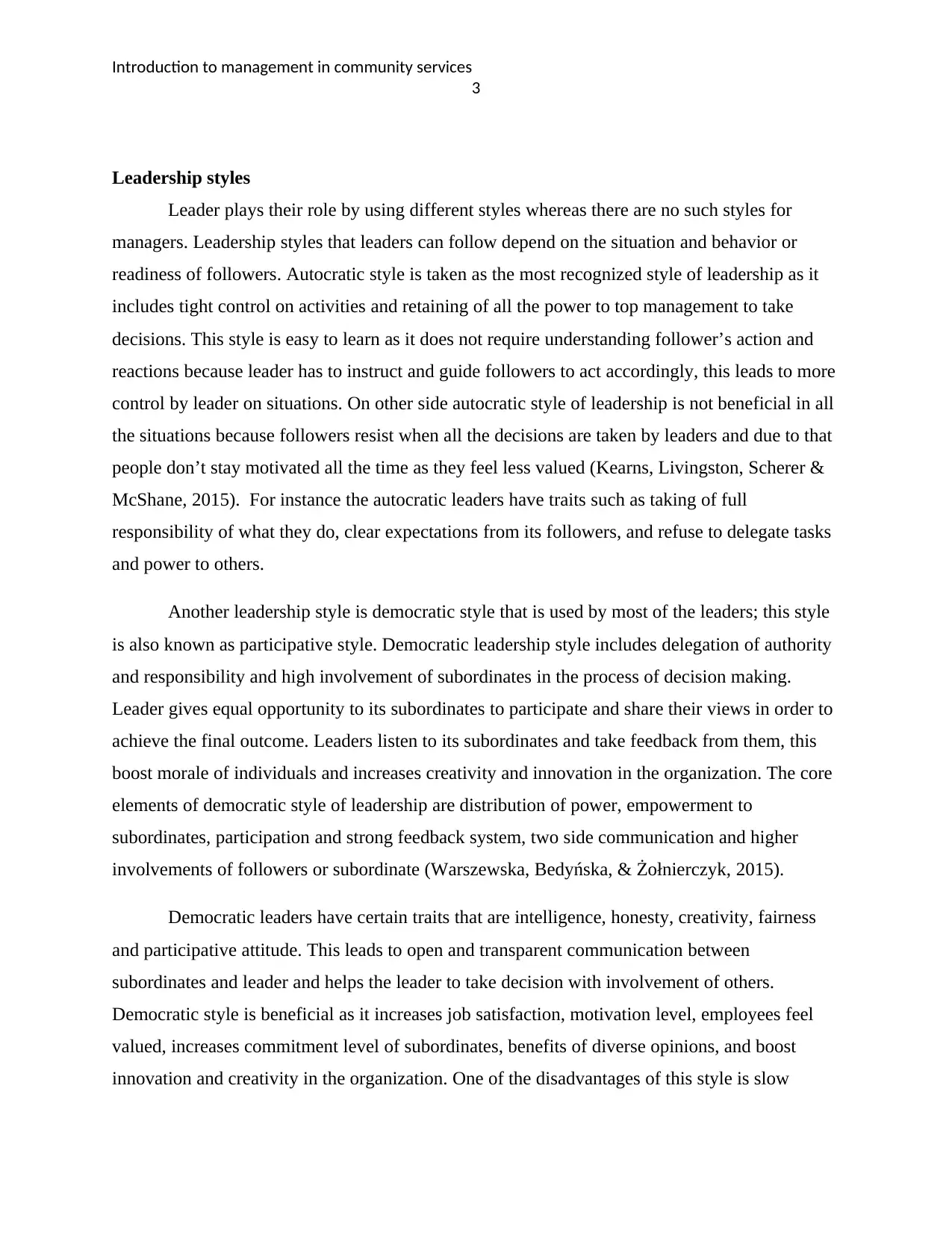
Introduction to management in community services
3
Leadership styles
Leader plays their role by using different styles whereas there are no such styles for
managers. Leadership styles that leaders can follow depend on the situation and behavior or
readiness of followers. Autocratic style is taken as the most recognized style of leadership as it
includes tight control on activities and retaining of all the power to top management to take
decisions. This style is easy to learn as it does not require understanding follower’s action and
reactions because leader has to instruct and guide followers to act accordingly, this leads to more
control by leader on situations. On other side autocratic style of leadership is not beneficial in all
the situations because followers resist when all the decisions are taken by leaders and due to that
people don’t stay motivated all the time as they feel less valued (Kearns, Livingston, Scherer &
McShane, 2015). For instance the autocratic leaders have traits such as taking of full
responsibility of what they do, clear expectations from its followers, and refuse to delegate tasks
and power to others.
Another leadership style is democratic style that is used by most of the leaders; this style
is also known as participative style. Democratic leadership style includes delegation of authority
and responsibility and high involvement of subordinates in the process of decision making.
Leader gives equal opportunity to its subordinates to participate and share their views in order to
achieve the final outcome. Leaders listen to its subordinates and take feedback from them, this
boost morale of individuals and increases creativity and innovation in the organization. The core
elements of democratic style of leadership are distribution of power, empowerment to
subordinates, participation and strong feedback system, two side communication and higher
involvements of followers or subordinate (Warszewska, Bedyńska, & Żołnierczyk, 2015).
Democratic leaders have certain traits that are intelligence, honesty, creativity, fairness
and participative attitude. This leads to open and transparent communication between
subordinates and leader and helps the leader to take decision with involvement of others.
Democratic style is beneficial as it increases job satisfaction, motivation level, employees feel
valued, increases commitment level of subordinates, benefits of diverse opinions, and boost
innovation and creativity in the organization. One of the disadvantages of this style is slow
3
Leadership styles
Leader plays their role by using different styles whereas there are no such styles for
managers. Leadership styles that leaders can follow depend on the situation and behavior or
readiness of followers. Autocratic style is taken as the most recognized style of leadership as it
includes tight control on activities and retaining of all the power to top management to take
decisions. This style is easy to learn as it does not require understanding follower’s action and
reactions because leader has to instruct and guide followers to act accordingly, this leads to more
control by leader on situations. On other side autocratic style of leadership is not beneficial in all
the situations because followers resist when all the decisions are taken by leaders and due to that
people don’t stay motivated all the time as they feel less valued (Kearns, Livingston, Scherer &
McShane, 2015). For instance the autocratic leaders have traits such as taking of full
responsibility of what they do, clear expectations from its followers, and refuse to delegate tasks
and power to others.
Another leadership style is democratic style that is used by most of the leaders; this style
is also known as participative style. Democratic leadership style includes delegation of authority
and responsibility and high involvement of subordinates in the process of decision making.
Leader gives equal opportunity to its subordinates to participate and share their views in order to
achieve the final outcome. Leaders listen to its subordinates and take feedback from them, this
boost morale of individuals and increases creativity and innovation in the organization. The core
elements of democratic style of leadership are distribution of power, empowerment to
subordinates, participation and strong feedback system, two side communication and higher
involvements of followers or subordinate (Warszewska, Bedyńska, & Żołnierczyk, 2015).
Democratic leaders have certain traits that are intelligence, honesty, creativity, fairness
and participative attitude. This leads to open and transparent communication between
subordinates and leader and helps the leader to take decision with involvement of others.
Democratic style is beneficial as it increases job satisfaction, motivation level, employees feel
valued, increases commitment level of subordinates, benefits of diverse opinions, and boost
innovation and creativity in the organization. One of the disadvantages of this style is slow
Paraphrase This Document
Need a fresh take? Get an instant paraphrase of this document with our AI Paraphraser
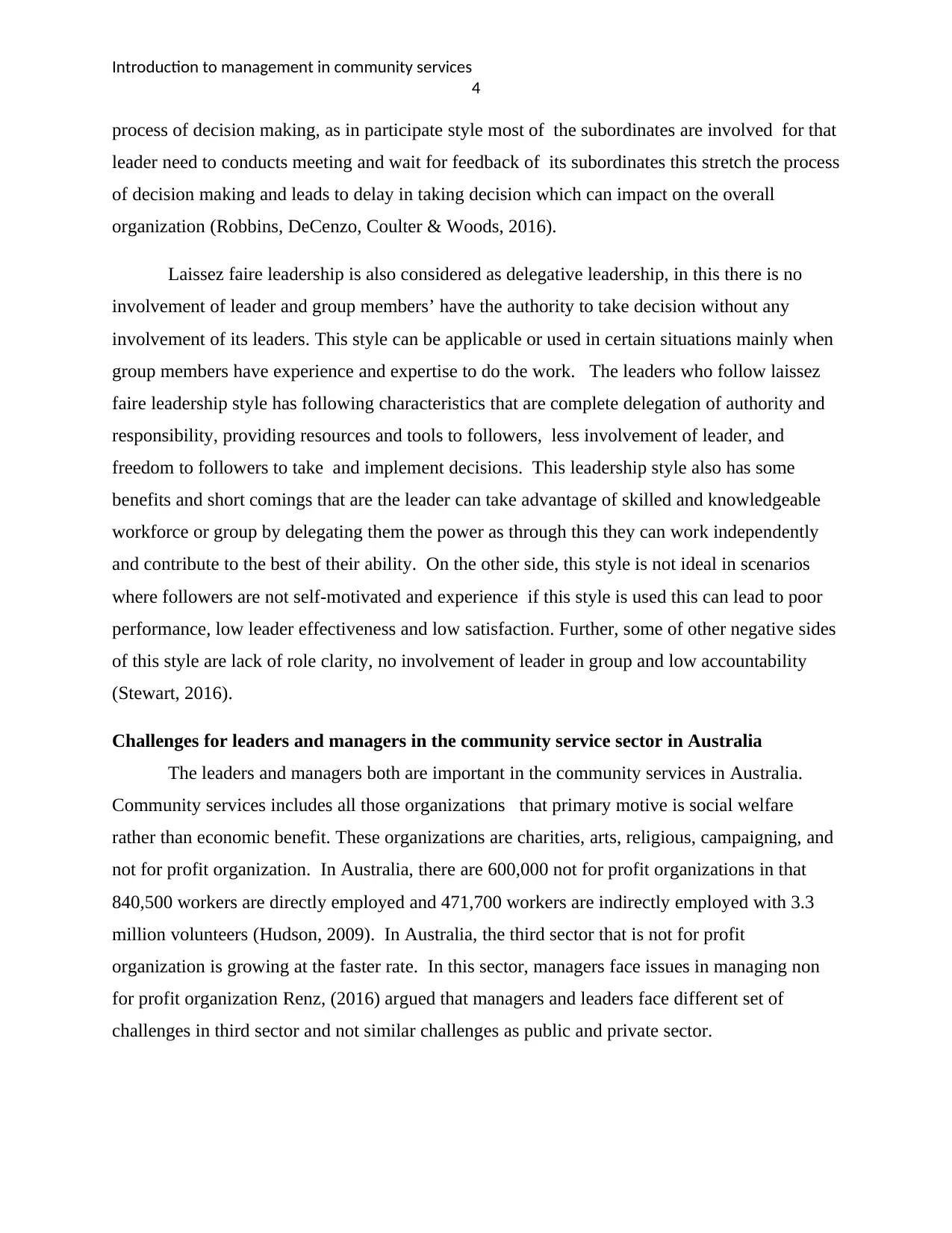
Introduction to management in community services
4
process of decision making, as in participate style most of the subordinates are involved for that
leader need to conducts meeting and wait for feedback of its subordinates this stretch the process
of decision making and leads to delay in taking decision which can impact on the overall
organization (Robbins, DeCenzo, Coulter & Woods, 2016).
Laissez faire leadership is also considered as delegative leadership, in this there is no
involvement of leader and group members’ have the authority to take decision without any
involvement of its leaders. This style can be applicable or used in certain situations mainly when
group members have experience and expertise to do the work. The leaders who follow laissez
faire leadership style has following characteristics that are complete delegation of authority and
responsibility, providing resources and tools to followers, less involvement of leader, and
freedom to followers to take and implement decisions. This leadership style also has some
benefits and short comings that are the leader can take advantage of skilled and knowledgeable
workforce or group by delegating them the power as through this they can work independently
and contribute to the best of their ability. On the other side, this style is not ideal in scenarios
where followers are not self-motivated and experience if this style is used this can lead to poor
performance, low leader effectiveness and low satisfaction. Further, some of other negative sides
of this style are lack of role clarity, no involvement of leader in group and low accountability
(Stewart, 2016).
Challenges for leaders and managers in the community service sector in Australia
The leaders and managers both are important in the community services in Australia.
Community services includes all those organizations that primary motive is social welfare
rather than economic benefit. These organizations are charities, arts, religious, campaigning, and
not for profit organization. In Australia, there are 600,000 not for profit organizations in that
840,500 workers are directly employed and 471,700 workers are indirectly employed with 3.3
million volunteers (Hudson, 2009). In Australia, the third sector that is not for profit
organization is growing at the faster rate. In this sector, managers face issues in managing non
for profit organization Renz, (2016) argued that managers and leaders face different set of
challenges in third sector and not similar challenges as public and private sector.
4
process of decision making, as in participate style most of the subordinates are involved for that
leader need to conducts meeting and wait for feedback of its subordinates this stretch the process
of decision making and leads to delay in taking decision which can impact on the overall
organization (Robbins, DeCenzo, Coulter & Woods, 2016).
Laissez faire leadership is also considered as delegative leadership, in this there is no
involvement of leader and group members’ have the authority to take decision without any
involvement of its leaders. This style can be applicable or used in certain situations mainly when
group members have experience and expertise to do the work. The leaders who follow laissez
faire leadership style has following characteristics that are complete delegation of authority and
responsibility, providing resources and tools to followers, less involvement of leader, and
freedom to followers to take and implement decisions. This leadership style also has some
benefits and short comings that are the leader can take advantage of skilled and knowledgeable
workforce or group by delegating them the power as through this they can work independently
and contribute to the best of their ability. On the other side, this style is not ideal in scenarios
where followers are not self-motivated and experience if this style is used this can lead to poor
performance, low leader effectiveness and low satisfaction. Further, some of other negative sides
of this style are lack of role clarity, no involvement of leader in group and low accountability
(Stewart, 2016).
Challenges for leaders and managers in the community service sector in Australia
The leaders and managers both are important in the community services in Australia.
Community services includes all those organizations that primary motive is social welfare
rather than economic benefit. These organizations are charities, arts, religious, campaigning, and
not for profit organization. In Australia, there are 600,000 not for profit organizations in that
840,500 workers are directly employed and 471,700 workers are indirectly employed with 3.3
million volunteers (Hudson, 2009). In Australia, the third sector that is not for profit
organization is growing at the faster rate. In this sector, managers face issues in managing non
for profit organization Renz, (2016) argued that managers and leaders face different set of
challenges in third sector and not similar challenges as public and private sector.
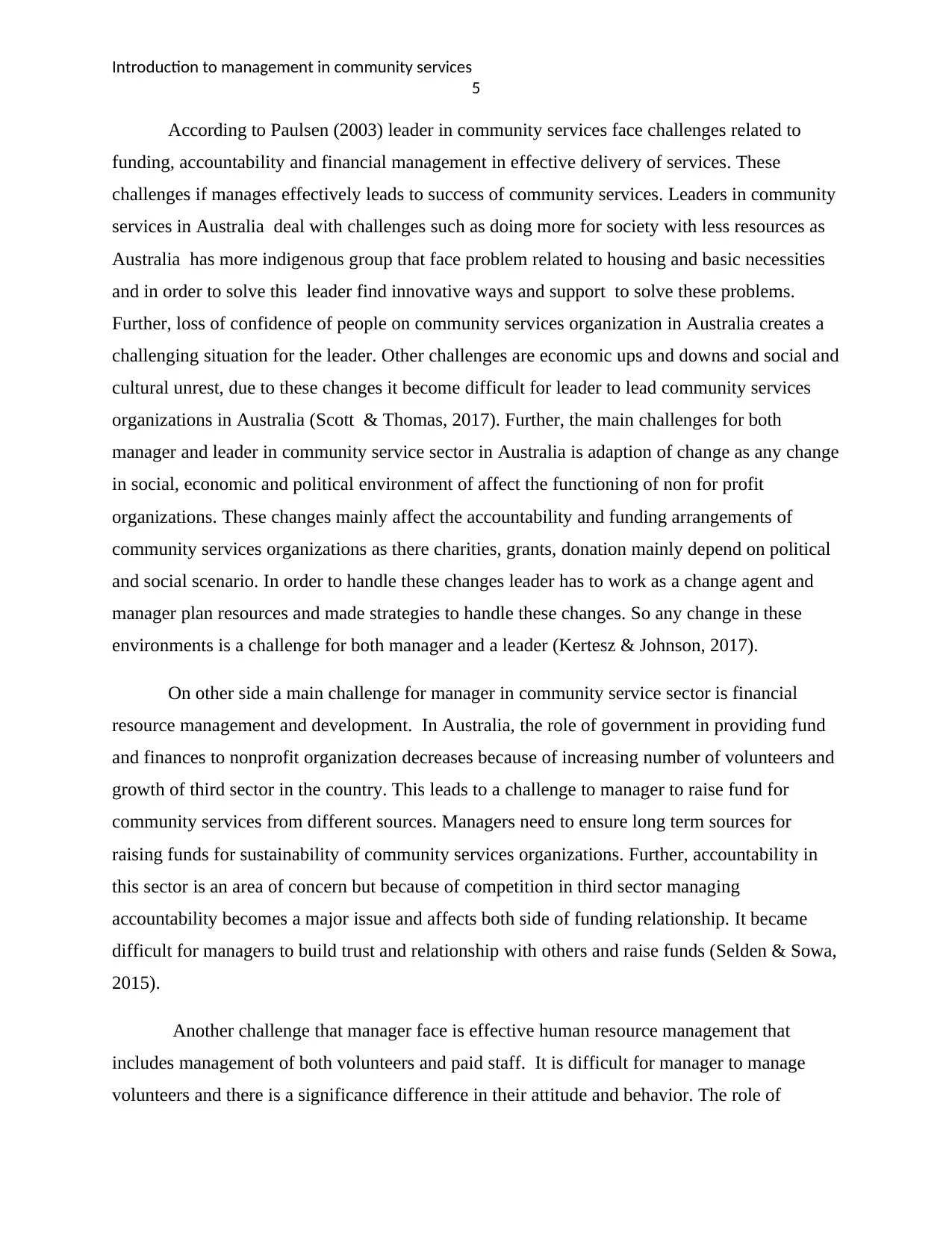
Introduction to management in community services
5
According to Paulsen (2003) leader in community services face challenges related to
funding, accountability and financial management in effective delivery of services. These
challenges if manages effectively leads to success of community services. Leaders in community
services in Australia deal with challenges such as doing more for society with less resources as
Australia has more indigenous group that face problem related to housing and basic necessities
and in order to solve this leader find innovative ways and support to solve these problems.
Further, loss of confidence of people on community services organization in Australia creates a
challenging situation for the leader. Other challenges are economic ups and downs and social and
cultural unrest, due to these changes it become difficult for leader to lead community services
organizations in Australia (Scott & Thomas, 2017). Further, the main challenges for both
manager and leader in community service sector in Australia is adaption of change as any change
in social, economic and political environment of affect the functioning of non for profit
organizations. These changes mainly affect the accountability and funding arrangements of
community services organizations as there charities, grants, donation mainly depend on political
and social scenario. In order to handle these changes leader has to work as a change agent and
manager plan resources and made strategies to handle these changes. So any change in these
environments is a challenge for both manager and a leader (Kertesz & Johnson, 2017).
On other side a main challenge for manager in community service sector is financial
resource management and development. In Australia, the role of government in providing fund
and finances to nonprofit organization decreases because of increasing number of volunteers and
growth of third sector in the country. This leads to a challenge to manager to raise fund for
community services from different sources. Managers need to ensure long term sources for
raising funds for sustainability of community services organizations. Further, accountability in
this sector is an area of concern but because of competition in third sector managing
accountability becomes a major issue and affects both side of funding relationship. It became
difficult for managers to build trust and relationship with others and raise funds (Selden & Sowa,
2015).
Another challenge that manager face is effective human resource management that
includes management of both volunteers and paid staff. It is difficult for manager to manage
volunteers and there is a significance difference in their attitude and behavior. The role of
5
According to Paulsen (2003) leader in community services face challenges related to
funding, accountability and financial management in effective delivery of services. These
challenges if manages effectively leads to success of community services. Leaders in community
services in Australia deal with challenges such as doing more for society with less resources as
Australia has more indigenous group that face problem related to housing and basic necessities
and in order to solve this leader find innovative ways and support to solve these problems.
Further, loss of confidence of people on community services organization in Australia creates a
challenging situation for the leader. Other challenges are economic ups and downs and social and
cultural unrest, due to these changes it become difficult for leader to lead community services
organizations in Australia (Scott & Thomas, 2017). Further, the main challenges for both
manager and leader in community service sector in Australia is adaption of change as any change
in social, economic and political environment of affect the functioning of non for profit
organizations. These changes mainly affect the accountability and funding arrangements of
community services organizations as there charities, grants, donation mainly depend on political
and social scenario. In order to handle these changes leader has to work as a change agent and
manager plan resources and made strategies to handle these changes. So any change in these
environments is a challenge for both manager and a leader (Kertesz & Johnson, 2017).
On other side a main challenge for manager in community service sector is financial
resource management and development. In Australia, the role of government in providing fund
and finances to nonprofit organization decreases because of increasing number of volunteers and
growth of third sector in the country. This leads to a challenge to manager to raise fund for
community services from different sources. Managers need to ensure long term sources for
raising funds for sustainability of community services organizations. Further, accountability in
this sector is an area of concern but because of competition in third sector managing
accountability becomes a major issue and affects both side of funding relationship. It became
difficult for managers to build trust and relationship with others and raise funds (Selden & Sowa,
2015).
Another challenge that manager face is effective human resource management that
includes management of both volunteers and paid staff. It is difficult for manager to manage
volunteers and there is a significance difference in their attitude and behavior. The role of
⊘ This is a preview!⊘
Do you want full access?
Subscribe today to unlock all pages.

Trusted by 1+ million students worldwide
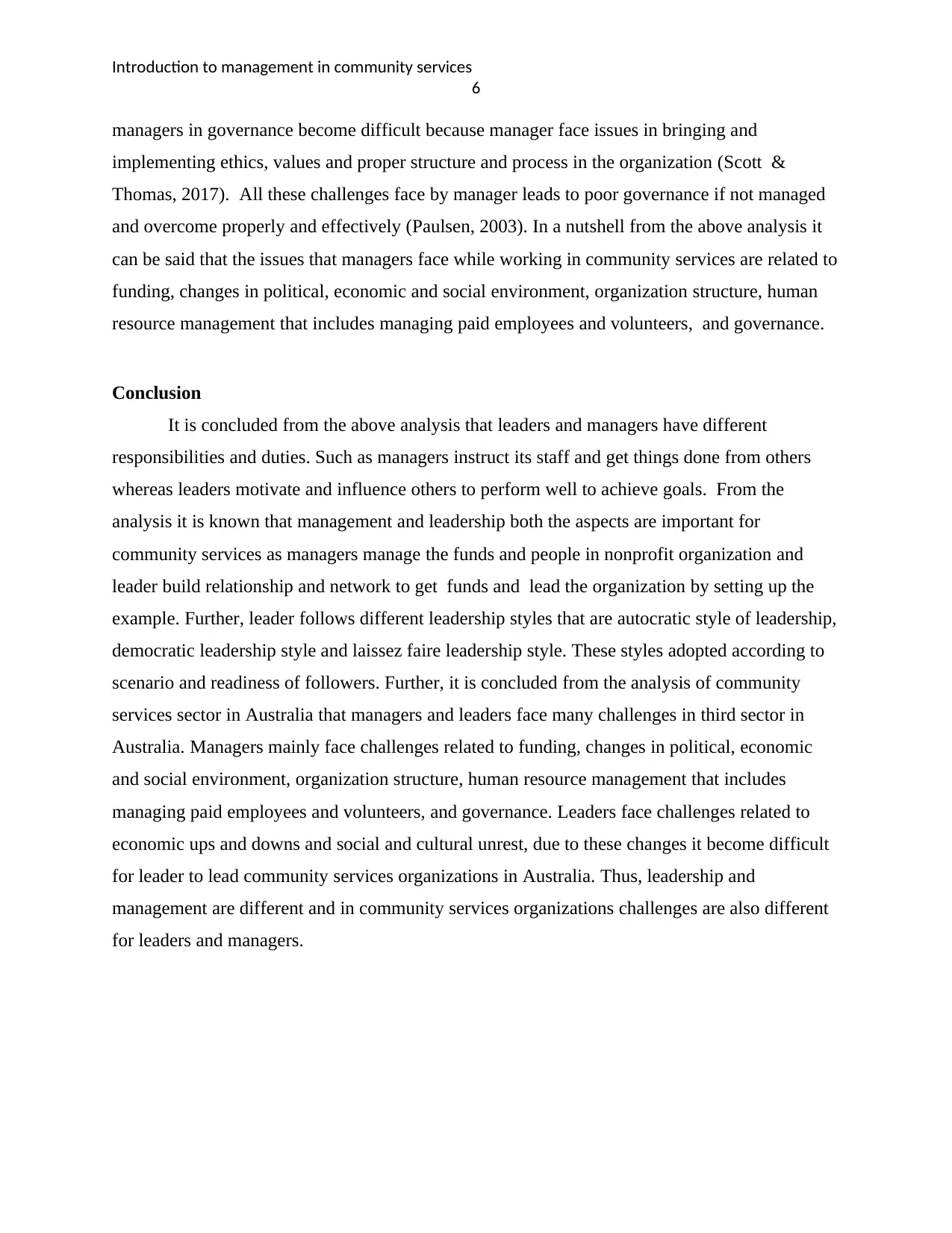
Introduction to management in community services
6
managers in governance become difficult because manager face issues in bringing and
implementing ethics, values and proper structure and process in the organization (Scott &
Thomas, 2017). All these challenges face by manager leads to poor governance if not managed
and overcome properly and effectively (Paulsen, 2003). In a nutshell from the above analysis it
can be said that the issues that managers face while working in community services are related to
funding, changes in political, economic and social environment, organization structure, human
resource management that includes managing paid employees and volunteers, and governance.
Conclusion
It is concluded from the above analysis that leaders and managers have different
responsibilities and duties. Such as managers instruct its staff and get things done from others
whereas leaders motivate and influence others to perform well to achieve goals. From the
analysis it is known that management and leadership both the aspects are important for
community services as managers manage the funds and people in nonprofit organization and
leader build relationship and network to get funds and lead the organization by setting up the
example. Further, leader follows different leadership styles that are autocratic style of leadership,
democratic leadership style and laissez faire leadership style. These styles adopted according to
scenario and readiness of followers. Further, it is concluded from the analysis of community
services sector in Australia that managers and leaders face many challenges in third sector in
Australia. Managers mainly face challenges related to funding, changes in political, economic
and social environment, organization structure, human resource management that includes
managing paid employees and volunteers, and governance. Leaders face challenges related to
economic ups and downs and social and cultural unrest, due to these changes it become difficult
for leader to lead community services organizations in Australia. Thus, leadership and
management are different and in community services organizations challenges are also different
for leaders and managers.
6
managers in governance become difficult because manager face issues in bringing and
implementing ethics, values and proper structure and process in the organization (Scott &
Thomas, 2017). All these challenges face by manager leads to poor governance if not managed
and overcome properly and effectively (Paulsen, 2003). In a nutshell from the above analysis it
can be said that the issues that managers face while working in community services are related to
funding, changes in political, economic and social environment, organization structure, human
resource management that includes managing paid employees and volunteers, and governance.
Conclusion
It is concluded from the above analysis that leaders and managers have different
responsibilities and duties. Such as managers instruct its staff and get things done from others
whereas leaders motivate and influence others to perform well to achieve goals. From the
analysis it is known that management and leadership both the aspects are important for
community services as managers manage the funds and people in nonprofit organization and
leader build relationship and network to get funds and lead the organization by setting up the
example. Further, leader follows different leadership styles that are autocratic style of leadership,
democratic leadership style and laissez faire leadership style. These styles adopted according to
scenario and readiness of followers. Further, it is concluded from the analysis of community
services sector in Australia that managers and leaders face many challenges in third sector in
Australia. Managers mainly face challenges related to funding, changes in political, economic
and social environment, organization structure, human resource management that includes
managing paid employees and volunteers, and governance. Leaders face challenges related to
economic ups and downs and social and cultural unrest, due to these changes it become difficult
for leader to lead community services organizations in Australia. Thus, leadership and
management are different and in community services organizations challenges are also different
for leaders and managers.
Paraphrase This Document
Need a fresh take? Get an instant paraphrase of this document with our AI Paraphraser
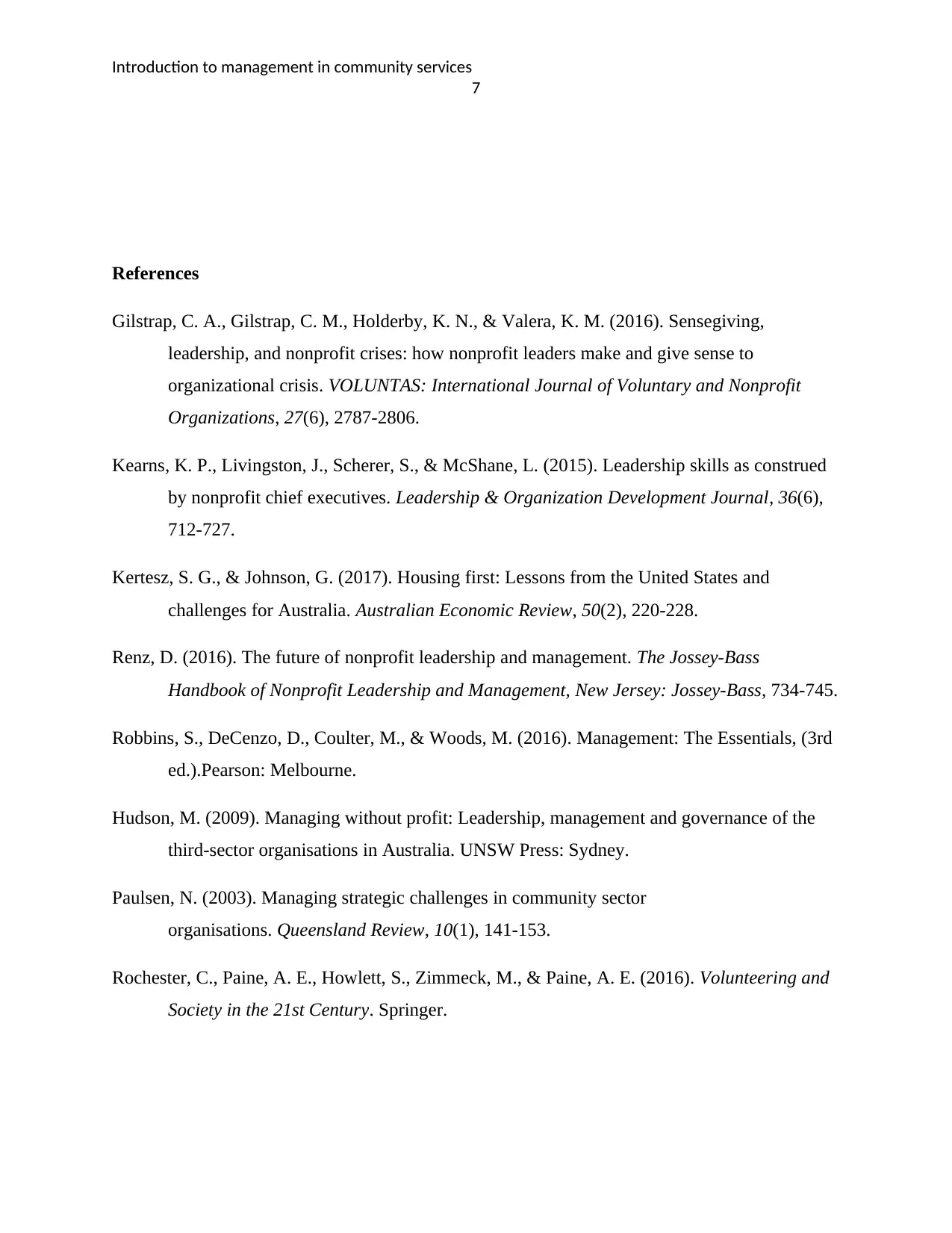
Introduction to management in community services
7
References
Gilstrap, C. A., Gilstrap, C. M., Holderby, K. N., & Valera, K. M. (2016). Sensegiving,
leadership, and nonprofit crises: how nonprofit leaders make and give sense to
organizational crisis. VOLUNTAS: International Journal of Voluntary and Nonprofit
Organizations, 27(6), 2787-2806.
Kearns, K. P., Livingston, J., Scherer, S., & McShane, L. (2015). Leadership skills as construed
by nonprofit chief executives. Leadership & Organization Development Journal, 36(6),
712-727.
Kertesz, S. G., & Johnson, G. (2017). Housing first: Lessons from the United States and
challenges for Australia. Australian Economic Review, 50(2), 220-228.
Renz, D. (2016). The future of nonprofit leadership and management. The Jossey-Bass
Handbook of Nonprofit Leadership and Management, New Jersey: Jossey-Bass, 734-745.
Robbins, S., DeCenzo, D., Coulter, M., & Woods, M. (2016). Management: The Essentials, (3rd
ed.).Pearson: Melbourne.
Hudson, M. (2009). Managing without profit: Leadership, management and governance of the
third-sector organisations in Australia. UNSW Press: Sydney.
Paulsen, N. (2003). Managing strategic challenges in community sector
organisations. Queensland Review, 10(1), 141-153.
Rochester, C., Paine, A. E., Howlett, S., Zimmeck, M., & Paine, A. E. (2016). Volunteering and
Society in the 21st Century. Springer.
7
References
Gilstrap, C. A., Gilstrap, C. M., Holderby, K. N., & Valera, K. M. (2016). Sensegiving,
leadership, and nonprofit crises: how nonprofit leaders make and give sense to
organizational crisis. VOLUNTAS: International Journal of Voluntary and Nonprofit
Organizations, 27(6), 2787-2806.
Kearns, K. P., Livingston, J., Scherer, S., & McShane, L. (2015). Leadership skills as construed
by nonprofit chief executives. Leadership & Organization Development Journal, 36(6),
712-727.
Kertesz, S. G., & Johnson, G. (2017). Housing first: Lessons from the United States and
challenges for Australia. Australian Economic Review, 50(2), 220-228.
Renz, D. (2016). The future of nonprofit leadership and management. The Jossey-Bass
Handbook of Nonprofit Leadership and Management, New Jersey: Jossey-Bass, 734-745.
Robbins, S., DeCenzo, D., Coulter, M., & Woods, M. (2016). Management: The Essentials, (3rd
ed.).Pearson: Melbourne.
Hudson, M. (2009). Managing without profit: Leadership, management and governance of the
third-sector organisations in Australia. UNSW Press: Sydney.
Paulsen, N. (2003). Managing strategic challenges in community sector
organisations. Queensland Review, 10(1), 141-153.
Rochester, C., Paine, A. E., Howlett, S., Zimmeck, M., & Paine, A. E. (2016). Volunteering and
Society in the 21st Century. Springer.
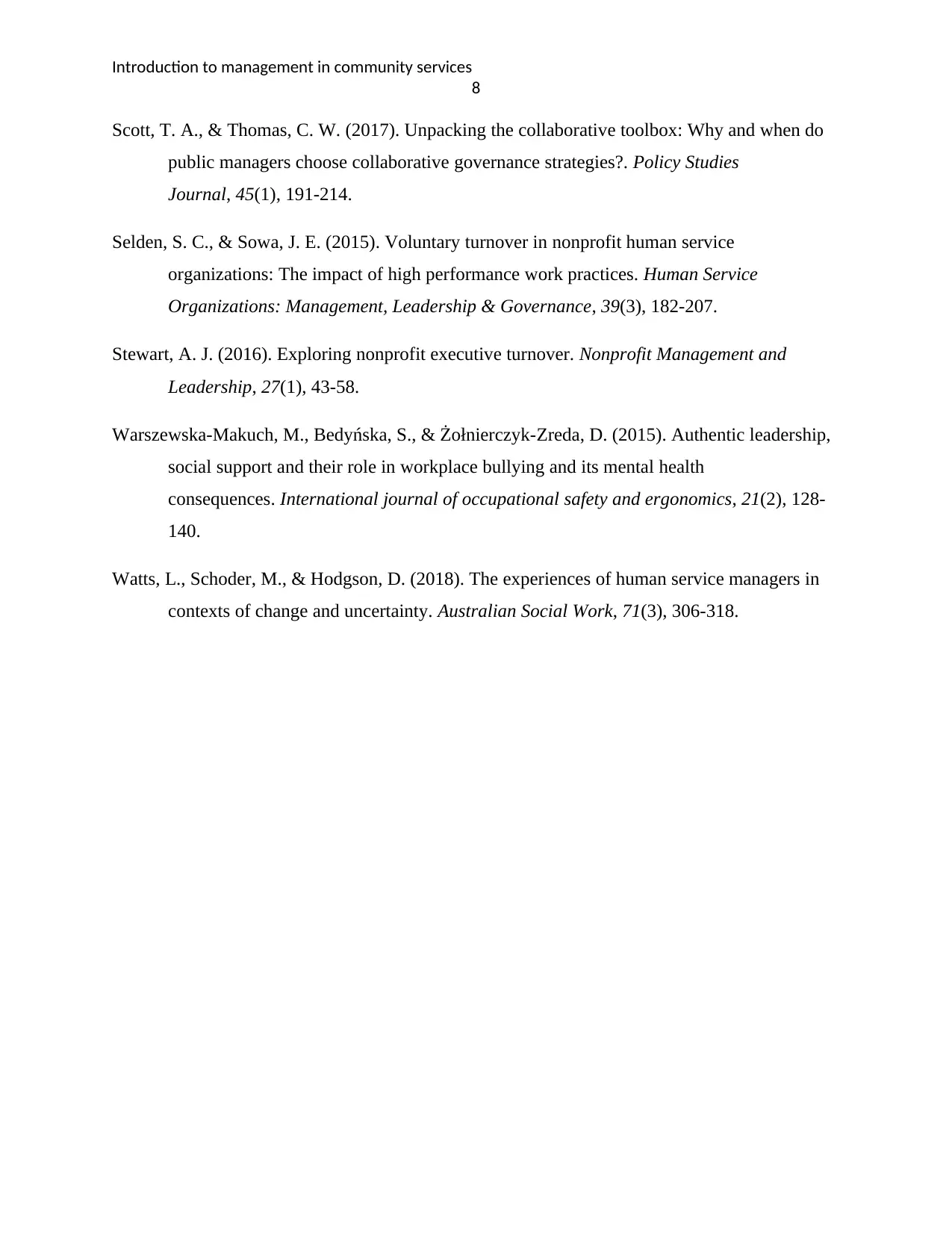
Introduction to management in community services
8
Scott, T. A., & Thomas, C. W. (2017). Unpacking the collaborative toolbox: Why and when do
public managers choose collaborative governance strategies?. Policy Studies
Journal, 45(1), 191-214.
Selden, S. C., & Sowa, J. E. (2015). Voluntary turnover in nonprofit human service
organizations: The impact of high performance work practices. Human Service
Organizations: Management, Leadership & Governance, 39(3), 182-207.
Stewart, A. J. (2016). Exploring nonprofit executive turnover. Nonprofit Management and
Leadership, 27(1), 43-58.
Warszewska-Makuch, M., Bedyńska, S., & Żołnierczyk-Zreda, D. (2015). Authentic leadership,
social support and their role in workplace bullying and its mental health
consequences. International journal of occupational safety and ergonomics, 21(2), 128-
140.
Watts, L., Schoder, M., & Hodgson, D. (2018). The experiences of human service managers in
contexts of change and uncertainty. Australian Social Work, 71(3), 306-318.
8
Scott, T. A., & Thomas, C. W. (2017). Unpacking the collaborative toolbox: Why and when do
public managers choose collaborative governance strategies?. Policy Studies
Journal, 45(1), 191-214.
Selden, S. C., & Sowa, J. E. (2015). Voluntary turnover in nonprofit human service
organizations: The impact of high performance work practices. Human Service
Organizations: Management, Leadership & Governance, 39(3), 182-207.
Stewart, A. J. (2016). Exploring nonprofit executive turnover. Nonprofit Management and
Leadership, 27(1), 43-58.
Warszewska-Makuch, M., Bedyńska, S., & Żołnierczyk-Zreda, D. (2015). Authentic leadership,
social support and their role in workplace bullying and its mental health
consequences. International journal of occupational safety and ergonomics, 21(2), 128-
140.
Watts, L., Schoder, M., & Hodgson, D. (2018). The experiences of human service managers in
contexts of change and uncertainty. Australian Social Work, 71(3), 306-318.
⊘ This is a preview!⊘
Do you want full access?
Subscribe today to unlock all pages.

Trusted by 1+ million students worldwide
1 out of 9
Related Documents
Your All-in-One AI-Powered Toolkit for Academic Success.
+13062052269
info@desklib.com
Available 24*7 on WhatsApp / Email
![[object Object]](/_next/static/media/star-bottom.7253800d.svg)
Unlock your academic potential
Copyright © 2020–2025 A2Z Services. All Rights Reserved. Developed and managed by ZUCOL.





